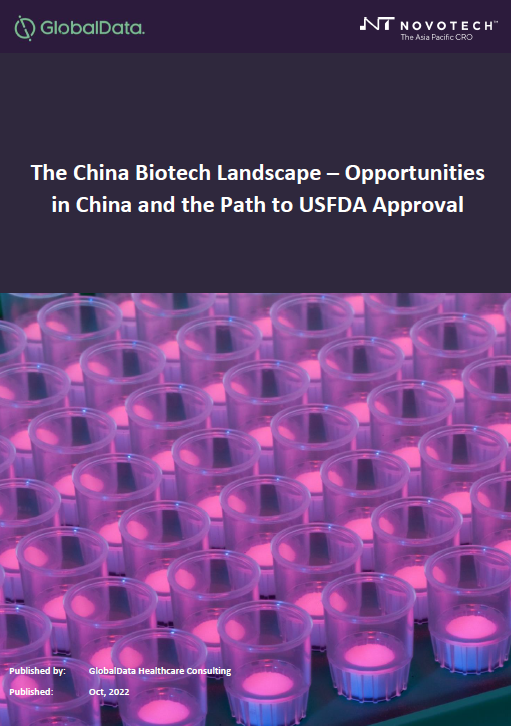
Increasingly, pharmaceutical companies around the world are looking to capitalise on value creation across different geographic regions through the utilisation of novel technologies and leveraging of the skilled resources needed to develop them at optimal development cost and time. In this quest to meet global clinical requirements, a number of biopharma firms are turning to China, thanks to the range of benefits the region can offer.
Since 2015, the Chinese government has doubled its support for biotech, investing huge amounts of money to stimulate innovation in the sector, both to meet huge domestic unmet needs in healthcare and to be competitive on the world stage. As a result, China recorded the largest number of new trials during the analysis period between 2017 to 2021 with the number of new trials doubling during this period.
Local innovation
The Novotech/GlobalData report, titled The China Biotech Landscape – Opportunities in China and the Path to USFDA Approva[1]l, cites China’s updated regulatory framework as a key driver for western biotechs considering new geographies, particularly as the recent revamp has helped to accelerate drug approvals in the country.
These rapid regulatory reforms have played a key role in faster drug development, with Chinese biopharma innovations beginning to gain worldwide recognition. According to the report: “China’s regulatory reforms in 2018 allow acceptance of foreign clinical trials data for drug approval, making it easier for foreign companies to enter the Chinese market. China’s clinical development regulations are aligned with the United States Food and Drug Administration (USFDA) regulations and present several benefits to western biopharma companies.”
What’s more, recent pharma patent reforms introduced by China, including the introduction of patent term extension for drugs and the patent term compensation system, are also likely to attract foreign companies. Further foreign direct investment interest is pulled from the favourable government policies available, helping to enhance domestic and global innovation and fund research and development (R&D). Much of this is leading to local innovation, with key players building up technology platforms and investing in new therapy modalities in collaboration with universities and local biotech companies. In turn, these strategic partnerships can provide access to local development and commercialisation.
Biopharma firms will also find an abundance of skilled resource in the region, including a large, high-quality domestic talent pool as well as talent returning from overseas with expertise in drug development. Similarly, China offers access to a large and diverse patient population.
Additionally, western biotech companies can enter the Chinese market without setting up their own manufacturing facility in China by designating a Marketing Authorization Holder (MAH) to conduct clinical trials and commercialise their drug in China. MAHs can be either a local legal entity or manufacturer, a medical research institution or a biotech company, or a Contract Research Organisation/Contract Development and Manufacturing Organisation.
Strategic partnerships
But just as western biotechs are seeking a foothold in new territories, so too are those in China. Chinese biopharma companies can enter developed markets in the US and Europe through strategic partnerships or by setting up their own operations in these markets and recent years have seen the USFDA approve several compounds developed by Chinese companies based on results from trials conducted in China.
In fact, Chinese companies and researchers now play a key role in US biotechnology innovation. Through US-based R&D centres and incubators, corporate and academic partnerships, and a large cohort of Chinese researchers in US academic institutions and companies, the industry has witnessed a significant uptick in investments by Chinese investors into US early-stage biotechnology companies since 2017, a movement heavily encouraged through the Made in China 2025 initiative.
However, a common challenge felt throughout this process is the USFDAs requirement for drugs tested in one country being too difficult to generalise to the US population due to differences in patient ethnicity. As a result, they require additional clinical trials that reflect US patients. To get their product approved in the US, Chinese drug manufacturers should engage with the USFDA early and formally to work out these nuances and gain upfront guidance.
Despite these stumbling blocks, the USFDA together with the European Medicines Agency (EMA), have defined a drug regulatory framework and streamlined drug development and approval processes to create a favourable regulatory environment, particularly when it comes to the acceptance of overseas clinical data for approval of new drugs or for initiating new trials in the US.
What to look for in a CRO partner
Achieving a seamless expansion into a new market – whether it’s as a Chinese biotech moving into the US, or a western pharma company moving into an APAC territory – requires a strong partnership with an established CRO. Key attributes to look for include technical readiness, modern infrastructure, the experience of personnel in the specific market segment, know-how in providing innovative solutions, knowledge of the regulatory aspects of the market of interest, a global presence, and price competitiveness.
Novotech is a leading biotech specialist CRO operating in Asia Pacific with global services. Site relationships and strong clinical teams in China and Hong Kong together with deep local knowledge enables it to deliver quality CRO services to biotechnology companies. It fully leverages its global network by deploying a shared service centre in China where its well-established systems and processes are able to bring down costs without compromising on quality.
To find out more on the Chinese biotech landscape and how a CRO like Novotech can help you to leverage the opportunities there, download the whitepaper below.
[1] GlobalData Healthcare Consulting in collaboration with Novotech, May 2022. “The China Biotech Landscape – Opportunities in China and the Path to USFDA Approval”



